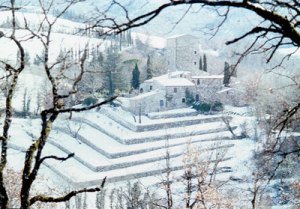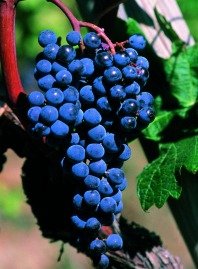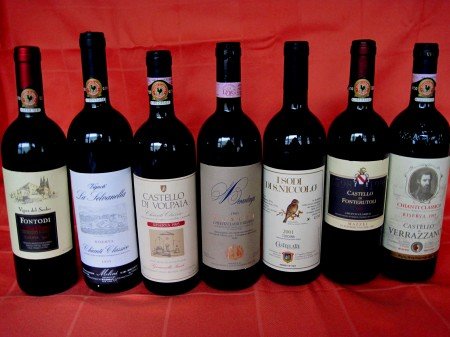Views: 33
Chianti Classico Riserva: Complex in Every Sense
By Tom Maresca, from his blog posted on 2010/01/27 at:
http://ubriaco.wordpress.com/2010/01/27/chianti-classico-riserva-complex-in-every-sense/
I think Chianti Classico riserva can stand with the world’s finest red wines. Not all riservas from every maker, in every vintage, by any means – but at the top of its game, a Chianti Classico riserva matches the elegance and complexity, the sapidity and depth, of a great Bordeaux. It’s a different wine, of course, marked by that characteristically Italian acidity and a core of typically Sangiovese winy, cherry flavors that persists even into old age – but on its own terms, it is a great wine, well worth buying young and patiently cellaring.

A Chianti Classico estate in winter
It’s not just the wine that is complex, of course. For all the reasons I talked about in my last post, the Chianti Classico riserva situation can be very confusing. There are only a few fixed points in this very moving picture. What must distinguish a riserva from a normal Chianti Classico mostly boils down to aging: longer time in barrel and/or bottle is mandatory. After that, a lot is up for grabs. From any reputable producer, a riserva bottling indicates a superior batch of primary material: either a selection of the best grapes from all the vineyards available (this usually bears a fantasy name or simply the designation riserva), or grapes from one esteemed vineyard (which usually bears the vineyard name in addition to the designation riserva). And just to compound the possible confusion: Many wines that used to be Supertuscans and are now IGT could be classified as DOCG Chianti Classico if their producers so wished.
Got all that? There will be a quiz.

Sangiovese grapes
Many of these wines nowadays will be 100% Sangiovese, or very near to it. The work of the Chianti Classico 2000 Project has made available a range of Sangiovese clones adapted to most of the microclimatic niches of this very varied zone, so the possibilities of working with this quintessentially Tuscan grape have proliferated.
For traditionalists, if blending is to be done (up to 20% other red varieties are now permitted), the chief candidates are usually Canaiolo or Colorino or Mammolo, ancient local varieties now regaining respect. For modernists (these terms have to be taken loosely: every Italian winemaker is now de facto a modernist), the varieties of choice will be Cabernet – a fading star – or the currently more popular Merlot or Syrah.
The impact of each of these varieties on Sangiovese – especially if used to the full permissible 20% – is very different and can be formidable. Cabernet adds its own distinctive cedary, dark flavor notes. Merlot softens the wine and adds a little mulberryish fruit. Syrah gives a distinctive peppery note. Any of these effects can be compounded if the blended wine or any of its components has been barriqued. For me, a strongly oaked wine – one in large part stored or fermented in new barriques – becomes almost undrinkable. A lot of new oak adds too much vanilla sweetness and the wrong tannins. It diminishes the wine’s acidity and obscures the characteristic Sangiovese fruit. All of that adds up to a wine that might be interesting on its own terms, but sure as hell isn’t Chianti on my terms.
So in buying Chianti Classico riserva, especially if you’re buying with an eye toward cellaring the wine and drinking it in its mature glory, you have to know the producers, know their style and habits. The best way to do this is to buy a mixed case of Chianti Classico riservas and taste for yourself. I can make suggestions, but keep in mind the limitations of my palate. I like more traditional wines, with pronounced Sangiovese character and minimally perceptible presence of oak. And I emphatically like older wines: If I can possibly help it, I never drink a riserva before its tenth birthday, and ideally I prefer it at around 15 years old. Bear all that in mind when you read these recommendations.

Some of my best friends
Badia a Coltibuono. This house is well known for the ability of its wines to age with grace. The Classico riserva is usually 90% Sangiovese and 10% Canaiolo. There are also 100% Sangiovese Chianti Classico RS and Sangioveto, both fine.
Castellare. Alessandro Cellai turns out big, dark, brooding wines from 90% Sangiovese (Vigna Il Poggiale riserva: the balance is other native red grapes) and especially from 85% Sangiovese and 15% Malvasia nera (I Sodi di San Niccolò; could be a Classico, but is still labeled IGT).
Castello di Ama. Vigneto Bellavista (80% Sangiovese, 20% Malvasia nera) shows a lighter hand; the emphasis is on elegance and grace.
Castello di Brolio. Once again among the leaders of the zone. Its flagship wine, Castello di Brolio, adds 5% Cabernet sauvignon to its Sangiovese, plus barrique aging, to produce one of the most successful modern-style Classicos.
Castello di Fonterutoli. Similar in style and accomplishment to Brolio, the Mazzei family’s Castello di Fonterutoli uses 10% Cabernet and about 18 months in barrique (happily, it tastes like much less) to produce beautiful balance and elegance.
Castello di Monsanto. Now 100% Sangiovese, the single-vineyard Il Poggio has an established track record of long and graceful aging. One of the zone’s stars.
Castello di Verrazzano. Passionately devoted to Sangiovese, this house produces fine 100% riserva as well as an excellent 100% Sangiovese IGT, Sassella.
Castello di Volpaia. Elegance and grace are the hallmarks of the Volpaia’s high-altitude vineyards – 100% Sangiovese riserva and especially the special-selection riserva Coltassala.
Felsina Berardenga. A great estate from the southern end of the zone, with a bit more weight and heft thereby. A fine riserva (100% Sangiovese); a brilliant single-vineyard riserva, Rancia (also 100% Sangiovese); and an equally fine IGT, Fontalloro, whose big-bodied 100% Sangiovese wears 18 months in barrique very lightly.
Fontodi. Some call Flaccianello della Pieve (100% Sangiovese IGT) modern style, but by any name it’s a wonderful wine, as is the 90% Sangiovese/10% Cabernet riserva Vigna del Sorbo.
Isole e Olena. Still classified an IGT as an homage to its beginnings as a revolutionary Supertuscan, Cepparello (100% Sangiovese) has become a benchmark for what the Classico zone can achieve.
Melini. This large, old Tuscan firm has long maintained a tradition of excellence with its single-vineyard, riserva La Selvanella, which has now evolved into a lovely 100% Sangiovese wine.
Villa Cafaggio. Elegant and big riserva from 100% Sangiovese and a similarly styled 100% Sangiovese IGT called Sanmartino reflect this house’s approach to the first-rate raw materials provided by its great site in the Conca d’oro, one of the Classico zone’s sweet spots.
As the star of the Supertuscans continues to fade, more and more Classico houses are investing their prestige and their best efforts in their riserva. The wines named above are just a fraction of the possibilities available to try. It’s time to start building your own list of favorites.
Thanks. Will take the time slowly the journey into the world of wines. BTW, I did ordered some gran bussia from rfw and hopefully will be delivered by march and plan to drink before the dawn of the summer heat.
[版主回覆02/03/2010 16:13:00]That's great, but rfw can sometimes be a long wait. Altaya is having its annual sale, with 12% off if you order a dozen or more.
I'm taking the opportunity to start a new discovery journey in Burgundy, after a "false start" years ago. Wine is fun because it takes you to places when you cannot move from your seat.